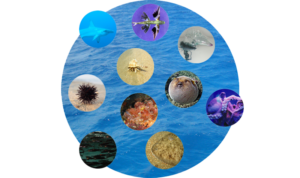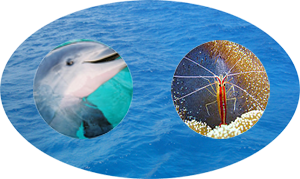Authenticity versus strategic self-preservation
What marine life has in common with behaviour at work
Do you show your real self to your team, employees and peers at work ?
Do you share your strenghts, weaknesses, dreams, feelings and what inspires you with other people ?
Or do you keep your vulnerability hidden beneath a solid shell that you change once in a while like the hermit crab on the ocean floor ?
Read this article about the features and benefits of authenticity at work , but first be introduced to the strategic aquarium at work .
To a prey animal of the wonderful underwater world survival means preventing being eaten. This is done through various strategies depending on the type :
- retreat
- release venom
- use camouflage
- mimic other venomous species, i.e. mimic with the purpose to deceive
- cover up and lie motionless
- forming schools, individual fish are less at risk when they swim together in large numbers
For the predator on the other hand it is crucial for its survival to understand all these mechanisms of prey and to disable their defence. Accordingly sharp senses, discreet pose or speed are of great importance. Moreover, the predator uses similar mechanisms as its prey, whereat escape is replaced by speed, and schooling becomes joint hunt.
By this I don’t mean to say in the least that executives or managers are predators . Don’t get me wrong ! Predators and prey can operate on all levels . It is the proactives versus the reactives , extroverts versus intraverts , etc with a lot of mixed forms. People are able to use either prey or predators’ strategies according to the situation.
What managers can learn from the predators is to develop their senses to understand more about behaviour at work as well as to understand themselves better to make way for effective communication and for authenticity to become a permission for all employees.
Similar to survival mechanisms of marine life people use – funny enough – the same survival strategies at work which are based on previous personal experiences . This is an unconscious process which often is no longer useful . Or even more , it gets in the way of honest, genuine connection with other people. Only self-awareness can be the start for behavioural change . Let’s have a look at some of these survival mechanisms in the underwater world .
Hover your mouse cursor over the images to learn about marine life and their survival strategies.

These behaviours are in my opinion all too common in the workplace and I would describe it as non-authentic behaviour or strategic self-preservation. In case of alleged danger based on past experiences employees will flee, freeze or fight (back). Some will hide or make themselves invisible. Others will imitate behaviour of colleagues or go underground (escape) either with or without conspiracy among companions. These mechanisms often pay off but unfortunately do not lead to effective communication within the organisation. If people at work need to be too strategic too often, the potential of management and employees is not fully exploited. Precious energy that could be used in a more positive way within the organisation is as a matter of fact wasted and leads to energy leaks.
What are the benefits and characteristics of authenticity at work ?
- creating an atmosphere of trust
- honest, open communication
- stress reduction
- what someone says is consistent with what he/she does, act with integrity
- no ambiguity but congruence, one’s body language is consistent with what he/she says
- maximum use of employees’ potential
- healthy relationships with mutual respect
- a motivated and engaged team
- a culture in which one can learn from mistakes
- vulnerability may be displayed
Step toward more authenticity at work now by subscribing to the free introductory course “More authentic in 5 weeks”.
What can we learn at work from marine life ?

Research in 2010 (wikipedia) ranks dolphins in the area of intelligence strait after people. This is thanks to their relatively large brains according to their body size, the highly developed neo cortex and their potential to experience complex emotions and recognise themselves. See also TEDX speaker Diana Reiss about ‘The dolphin in the mirror’.
It is believed that a combination of curiosity and a playful nature enables dolphins to have frequent contact with other animals and humans. Being part of a group is not fixed; exchange with other groups is common. Nevertheless, dolphins can establish strong social bonds. They will stay with injured or ill dolphins and will even help them to breathe by bringing them to the surface if needed.
The way cleaner wrasses and cleaner shrimp work with other species is a combination in which both parties benefit, a win-win situation. The cleaner keeps his host an its scales in good condition and in return it feeds on dead skin, parasites and debris. ( The Living Reef , National Geographic).
Which animal strategy do you apply at times ? And what would you like to change to become more authentic ?
Maybe you’re thinking of other marine life that you encounter on the workfloor. I’d love to hear about it.
Would you like to hear more news about authenticity and improving communication at work ? Subscribe to the Start2BU® newsletter here.

